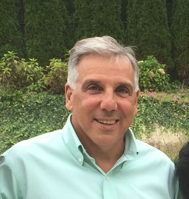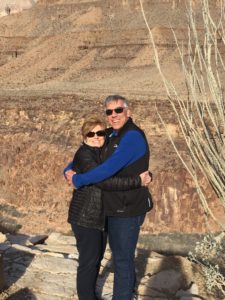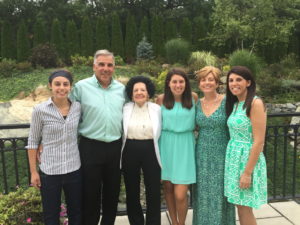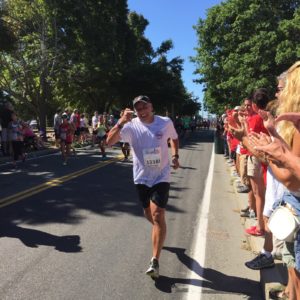Peter is an avid athlete, who enjoys swimming and running, a family man, and a professional. After experiencing a PE, he found himself with a lot of questions about the healing process and anxiety around getting back to embracing his athletic lifestyle. He found his answers at NATF’s Blood Clot Support Group.
How did you discover you had a PE?
My wife and I were away for a weekend with friends of ours and having a great time. Next thing I knew, it was dinner time, and I was having some pain in my stomach. I didn’t have a clue what it could be.
I thought to myself, “I think I’ll be okay. Everybody’s out and having a good time. I’m going to kind of go crash a little bit and maybe I’ll feel better.”
At three in the morning, I woke up and I was bent over in pain. I had no clue what to do. At about six in the morning, my wife woke up and we realized we needed to go to the hospital. Something was wrong with me.
I had a kidney stone.
I thought, “Okay, I can live with that.” The doctors decided to take it out. I figured, “Okay, I’m good.”
Low and behold, Thursday morning I was ready to go home, and the doctor came in and asked how I was feeling. He looked up and saw that my oxygen level was at 85.
“Is that good?” I asked him.
“Well no,” he replied. “It’s not good, something’s wrong with you.”
We needed to do more work to find out why my oxygen level was so low. They did some more tests. They came back on Friday and told me I had a pulmonary embolism (PE).
What was your reaction to that?
My first thought was, “Excuse me, what is that?”
“Well, what do I do now?” I said to the doctor, “I need some help.”
My old man had passed away two years ago, and the last thing he said to me was, “Make sure you take care of everybody.” I have three daughters, a beautiful wife, and my mother is 91 years old. I thought, “My job’s not done yet. Am I going to be okay?”
The doctors explained that I would be fine, it was just going to take some time to get back to normal again.
I had a lot of questions: How do I get myself back to square one? How do I get back on the road to go running? How do I go swimming? Are my girls going to be okay? What’s going to happen around me, and is this a reason for me to slow down?
I’m very outgoing. I’m competitive. I’m not one of those guys that’s going to kind of sit around waiting for something to happen. So, I said to myself, “Okay. We’re going to nip this thing in the bud, one way or another.”
What was it like after you got out of the hospital?
I left the hospital on Sunday. On Monday, I went for a walk and I felt really tired. “Why am I tired?” I wondered, not knowing enough about the PE. I did a little research and realized it was going to be some time before I got back to normal. It actually made me slow down and smell the roses.
I’m getting back out on the road, a little bit at a time. It’s like starting all over, like having an injury. That kind of brought me to the forefront of starting to walk, starting to run a little bit, getting back in the pool, and going back to work with my friends.
Peter became a patient of Dr. Samuel Goldhaber, who suggested he attend NATF’s Boston Blood Clot Support Group.
What made you attend support group?
I realized that I wasn’t really myself. I normally wake up in the morning with a “let’s go” attitude. I’m one of those guys that says, “Okay, let’s get going. We’re going to have breakfast, and we’re going to go out. Let’s go do something.”
Instead, I was kind of just lethargic. I wasn’t being myself.
At first, I thought I could deal with it myself, but I had the support group on my calendar at home on the refrigerator. I had never been to something like that.
I said to my wife, “Donna, I think I want to go to see this. I want to see what this is all about.”
And she replied, “Let’s go, if that’s going to make you feel better. You know what, because you’re not yourself.”
That was one of the problems. If she can notice it and my kids can notice it and I can notice it, I really needed some help.
What was your first support group like?
We showed up at the meeting, sat at the table, and we looked around. I thought, “Oh my goodness gracious. This is pretty cool, because I’m not the only one out there that’s like this.”
I can remember that night, it was pouring buckets out and I looked over to my left and there was a gentleman in biking shoes and a biking helmet. He told me, “You can get back. Believe me, you can get back and you’ll be okay.”
I felt so good when I left that night.
I remember one other person sat right at the corner of the table, across from me, and as we were leaving, she said “Peter, come here a minute.”
Now, I didn’t know this woman. She just gave me a big fat hug. I said, “Thank you for that, but what’s that for?”
She said, “Nineteen years ago, I sat in your same hair, petrified. I’ve seen the fear in your face and I want to let you know that you’re not alone, that this is going to make you better. You will be okay. It’s just a matter of time before you can grasp this whole thing of emotion and anxiety, and put that to rest.”
It has been great to see that every day people go through this, and they are able to be okay.
What has been the biggest adjustment for you?
I had never taken any medication before, until I started to take one Xarelto pill a day.
I realized that life really doesn’t change. Though, there are still symptoms. I get a little bit tired and, if I’m on a trip, I need to kind of get up and walk around.
It’s important to know what you can do and what you can’t do. If I didn’t show up at a support group, I’d be on my own trying to guess all the time.
How are you feeling now?
It all started February 27th, and then I was diagnosed on March 4th. I’m six months out, and so far, so good. I’m kind of back to reality and I’m doing things I wanted to do before. Work is better. I can kind of do what I wanted to do, whereas before I had a lot of questions
I can’t thank Dr. Goldhaber and NATF enough for introducing me to the support group. It’s been so helpful knowing that that’s there.



